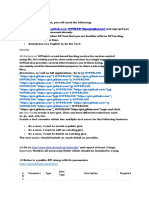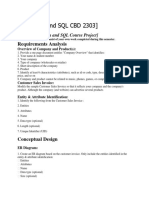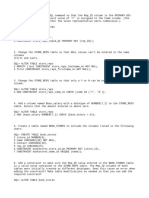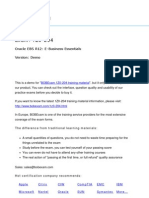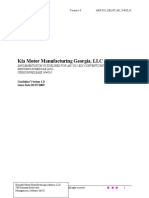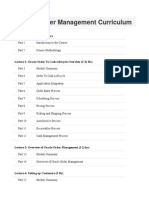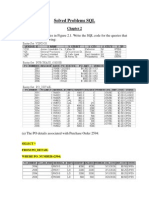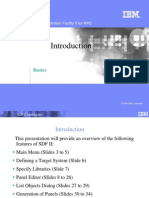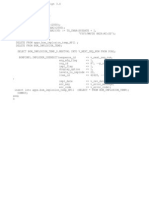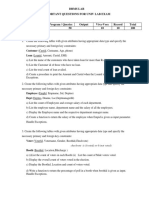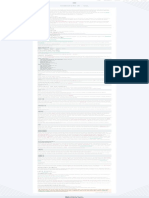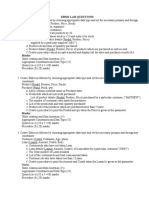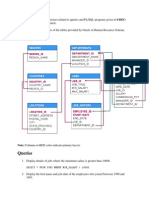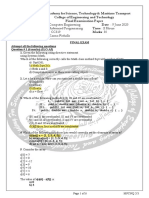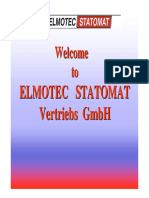Sheet 2 RDB SQL
Sheet 2 RDB SQL
Uploaded by
azzoz0599Copyright:
Available Formats
Sheet 2 RDB SQL
Sheet 2 RDB SQL
Uploaded by
azzoz0599Original Title
Copyright
Available Formats
Share this document
Did you find this document useful?
Is this content inappropriate?
Copyright:
Available Formats
Sheet 2 RDB SQL
Sheet 2 RDB SQL
Uploaded by
azzoz0599Copyright:
Available Formats
IE462 Sheet #2: SQL 2.1 Consider the tables in the given figures.
Write the SQL code for the queries that will return the following:
(a) The PO details associated with Purchase Order 2594:
(b) The list of purchase order numbers, without duplication, that have an OPEN line item:
(c) The following PO details from purchase orders placed with Vendor V250: PO_NUMBER, PO_LINE_ITEM, MATERIAL_ID, QUANTITY, UNIT_COST, TOTAL_COST (QUANTITY UNIT_COST): (d) Repeat part c, but order the result by TOTAL_COST increasing:
(e) Return the number of purchase orders whose PO_AMT is greater than 3000:
(f) Return the vendor ID, without duplication, of any vendor having an open PO line item where quantity times unit cost is more than $500:
2.2 The human resources department of an enterprise maintains a database on the companys employees in order to track their qualifications at various skill levels. The tables are as follows.
All attributes are text data types except DATE_QUALIFIED, which is a date data type. The database can be downloaded from the web site supporting this book.
(a) Identify the primary key(s) and foreign key(s) of each table. (b) Write the SQL commands to return the following data from the database: (1) The first and last names of the employees who work in Department 30: (2) The first and last names of employees with the SKILL_ID of 110 (3) The first and last names of the employees who are C Programmers (4) The number of Java Programmers in Department 30 (5) The last and first names of the Java Programmers in Department 30 listed alphabetically by last name (6) The department ID and department name, listed without repetition, of any departments that do not have Java Programmers. 2.3 The ACME Machine Shop is a small job shop that does machining of components for customers that assemble finished products. The customers give ACME engineering drawings of parts and request production of parts from ACME as needed. The manager of the machine shop has used a database to try to organize some basic information on the customers parts and their machining requirements as well as scheduling information based on orders. The tables and their design requirements are shown here. The meaning of the tables is as follows: PART The parts produced by ACME PROCESS_PLAN The operations that must be performed to manufacture the parts MACHINE The machines used to manufacture the parts SCHEDULE A set of production schedules for part manufacture
(a) Write the SQL code that will generate answers to the following questions: (1) List all the entries from the parts table. (2) List the instances of parts that use raw material RM302. (3) List the instances of all parts, alphabetically ordered by part description. (4) List the instances of all schedules with lot sizes greater than 15. (5) List the instances of all parts that require machine M1. (6) List the machines and their average, minimum, and maximum unit machining times. (7) For each schedule, list the schedule ID, part number, operation number, machine ID, setup time, total machining time, and total time (setup plus machining). Be sure that each attribute column has a title. (8) List the tooling that is used with each raw material without repetition in the tuple. (9) List the schedule release date, part number that will be machined, and machine ID that will be used by schedule release date descending. (10) List the part number and machine ID that will be used in production on schedule release date 4/1/06. (11) List just the machine ID (without duplication) that will be used by schedules released on 4/1/06.
(12) Using a query/sub-query, list all the part numbers that have operations with a setup time greater than 8 minutes. (13) List the material ID and the number of pieces of raw material that will be required for all the scheduled job releases on 4/1/06. 2.4 The ACME metalworking Machine Shop has implemented a highly automated cellular manufacturing system. In this system, machines are grouped into autonomous machining cells, each attended by a robot for material handling. Parts to be machined are moved to the cells by an automated guided vehicle (AGV). When a part is taken to a specific cell, it is completely manufactured within that cell. Some parts can be produced in either cell. ACME has implemented two cells, as shown here:
ACME has designed a database and implemented some tables that describe the relationships between cells, machines, and the parts that they produce. The Access database can be downloaded from the web site supporting this book. The tables are shown here and have the following meaning: CELL Identifies the different cells MACHINE Identifies the different machines PART Identifies the different parts manufactured in the cells PROCESS_PLAN Identifies the different possible process plans that can be used to manufacture each part (some parts can be manufactured by more than one process plan) PROCESS_PLAN_STEP Defines each operation of each process plan and the machines used in the operation.
(a) For each table identify the primary key(s) and foreign key(s). (b) Write the SQL statements for the following: (1) A list of machines by cell.
(2) The minimum, maximum, and average processing time on a machine:
(3) The total machining time by cell and by part:
You might also like
- Answer Sheet: S N (1 P) : HWM - SQL Q P A (PK) A (FK)Document7 pagesAnswer Sheet: S N (1 P) : HWM - SQL Q P A (PK) A (FK)Jordan0% (2)
- TestDocument3 pagesTestisabellaNo ratings yet
- Database and SQL CBD 2303 Project OutlineDocument3 pagesDatabase and SQL CBD 2303 Project OutlineGagan Deep SinghNo ratings yet
- Hands OnDocument2 pagesHands Onkim euniceNo ratings yet
- Consolidated Performance Appraisals FYE 30 June 2022Document24 pagesConsolidated Performance Appraisals FYE 30 June 2022TUSIFUMUNGU RUGAMBWA INNOCENTNo ratings yet
- Exam: 1Z0-204: Oracle EBS R12: E-Business Essentials Version: DemoDocument11 pagesExam: 1Z0-204: Oracle EBS R12: E-Business Essentials Version: DemosurajthaparNo ratings yet
- ANSI X12 - DELJIT - 862 - V4010 - O - v1.0 - 20090225Document22 pagesANSI X12 - DELJIT - 862 - V4010 - O - v1.0 - 20090225MaraJadeBackstoneNo ratings yet
- Oracle Order Management CurriculumDocument6 pagesOracle Order Management CurriculumKarthikeya BandaruNo ratings yet
- Marriage Preparation: 1. Pre-Listening ExercisesDocument3 pagesMarriage Preparation: 1. Pre-Listening ExercisesHye HeeNo ratings yet
- Solved Problems SQLDocument8 pagesSolved Problems SQLazzoz0599No ratings yet
- SDFII Int PDFDocument38 pagesSDFII Int PDFAshwin ReddyNo ratings yet
- BOM Implosion TestDocument1 pageBOM Implosion TestHarshad ParabNo ratings yet
- DBMS LAB Important Questions For UNIV LABDocument6 pagesDBMS LAB Important Questions For UNIV LABVETRINo ratings yet
- Core Java Practicals SolutionsDocument62 pagesCore Java Practicals SolutionsYogesh NangareNo ratings yet
- Homework #1 - SQL - CMU 15-445 - 645 - Intro To Database Systems (Fall 2017)Document1 pageHomework #1 - SQL - CMU 15-445 - 645 - Intro To Database Systems (Fall 2017)alucardchaNo ratings yet
- 8255Document28 pages8255Gulam Rabbani Mohammed OsmanNo ratings yet
- Lab#3 4Document6 pagesLab#3 4Manjinder JudgeNo ratings yet
- CoreJAVA PracticalsDocument2 pagesCoreJAVA PracticalsKarmik PatelNo ratings yet
- LAB - 02 (Class Design Basics - Part-1) PDFDocument5 pagesLAB - 02 (Class Design Basics - Part-1) PDFAsafAhmadNo ratings yet
- Cs2258 Dbms Lab QuestionsDocument9 pagesCs2258 Dbms Lab QuestionsSneha Ramesh33% (3)
- Lab 8 MinchulSDocument5 pagesLab 8 MinchulSMin So0% (1)
- Category Assignment InterfaceDocument2 pagesCategory Assignment Interfacemohammad_ayub_3100% (1)
- SQL QueriesDocument4 pagesSQL QueriesAbhijeet BhaskarNo ratings yet
- Assignment #9-10 (4%) : Driver - Name (String), License - Number (String), Number - of - Tickets (Integer)Document1 pageAssignment #9-10 (4%) : Driver - Name (String), License - Number (String), Number - of - Tickets (Integer)prabh kaurNo ratings yet
- SQL Fundamentals - Practice 07Document2 pagesSQL Fundamentals - Practice 07Abby ARNo ratings yet
- Lab 3Document3 pagesLab 3AHMAD NABOTNo ratings yet
- PLSQL Project Semester 2 StudentDocument3 pagesPLSQL Project Semester 2 Studentssmile50% (2)
- PLC Ch4 ReviewDocument2 pagesPLC Ch4 ReviewJerry Klinefelter83% (6)
- Soal Ujian OracleDocument26 pagesSoal Ujian OracleAdityo Ashari0% (1)
- How To Make API WIPDocument2 pagesHow To Make API WIPHeriNo ratings yet
- Dbms Lab Record 2 Sem All Solved FullDocument9 pagesDbms Lab Record 2 Sem All Solved FullSandeep Singh SwainchNo ratings yet
- Lab Manual Week 03Document4 pagesLab Manual Week 03Syed Qaim raza100% (1)
- Kumpulan Soal Dan Jawaban SQLDocument17 pagesKumpulan Soal Dan Jawaban SQLReds MichaNo ratings yet
- MIS 310 TutorialDocument31 pagesMIS 310 TutorialShàhríàrõ Dã RàkínskìNo ratings yet
- DBMS Theory Assignment 1 (B)Document1 pageDBMS Theory Assignment 1 (B)Arun Kumar Singh0% (1)
- Oracle Data DictionaryDocument2 pagesOracle Data Dictionarysngiri012421No ratings yet
- bcsl-034 Lab PDFDocument7 pagesbcsl-034 Lab PDFmanoj kumarNo ratings yet
- Relational Databases ASSIGNMENT - 2: Name: Kapila Ravichandran Student ID: 8918716 Section: 2Document3 pagesRelational Databases ASSIGNMENT - 2: Name: Kapila Ravichandran Student ID: 8918716 Section: 2kapila raviNo ratings yet
- CUBA Hands On LabDocument133 pagesCUBA Hands On LabmatintokyoNo ratings yet
- SQL Project 1Document40 pagesSQL Project 1Rajjo 07100% (1)
- SWE Sheet7 NaguiMostafa 20012069Document13 pagesSWE Sheet7 NaguiMostafa 20012069nagui.mostafaNo ratings yet
- BD Lab 6Document2 pagesBD Lab 6CosminNo ratings yet
- bcsl-034 Lab PDFDocument7 pagesbcsl-034 Lab PDFmanoj kumarNo ratings yet
- Scanner TutorialDocument13 pagesScanner TutorialFarid MasoodNo ratings yet
- Java Assignment 3 OOP ATM 1Document2 pagesJava Assignment 3 OOP ATM 1Thái ThôngNo ratings yet
- JP 6 2 Practice SolutionDocument4 pagesJP 6 2 Practice SolutionNur Aini ArdianNo ratings yet
- Ip Lab Programs Full Cse Vii SemDocument85 pagesIp Lab Programs Full Cse Vii Semmaddy27263193267% (3)
- R 5Document70 pagesR 5vacdigital100% (1)
- CC 319 Final Spring 2020Document6 pagesCC 319 Final Spring 2020Manar AbdelmegedNo ratings yet
- Lesson 04 OracleDocument7 pagesLesson 04 OraclebeehodemanNo ratings yet
- Dhananjay UpadhyayDocument40 pagesDhananjay Upadhyayarpit375rajputNo ratings yet
- Database Management Systems. Digital Assignment-1: SLOT: L-35 L-36 PROF. SashikaranDocument18 pagesDatabase Management Systems. Digital Assignment-1: SLOT: L-35 L-36 PROF. SashikaranPriyanshu Gupta 18BIT0146No ratings yet
- LAB EXERCISE 3: Classes & Objects, OverloadingDocument12 pagesLAB EXERCISE 3: Classes & Objects, OverloadingMegha Dangayach 19BPS1127No ratings yet
- PL SQL AssignmentsDocument64 pagesPL SQL AssignmentsShri KrishnanNo ratings yet
- Stack Organization in Computer ArchitectureDocument9 pagesStack Organization in Computer ArchitectureDhruv RastogiNo ratings yet
- Solution Case Study CCNDocument7 pagesSolution Case Study CCNGhulam Muhiudin Solangi100% (1)
- Database System With Administration: Technical AssessmentDocument7 pagesDatabase System With Administration: Technical AssessmentRhea KimNo ratings yet
- Mastering Impromptu 7.5Document195 pagesMastering Impromptu 7.5idaya_cnNo ratings yet
- All Tasks Solved Immediate Download: Requirements For Business Intelligence Capstone ProjectDocument8 pagesAll Tasks Solved Immediate Download: Requirements For Business Intelligence Capstone ProjectShivaani AggarwalNo ratings yet
- RVPL Final ListDocument4 pagesRVPL Final Listhrishi77No ratings yet
- ABAP Basics - ModularizationDocument5 pagesABAP Basics - Modularizationgraj4690% (1)
- MCAPGDCA 2ND Semester LAB AssignmentDocument2 pagesMCAPGDCA 2ND Semester LAB AssignmentAshis PradhanNo ratings yet
- Ongc 2004a Rev 7Document78 pagesOngc 2004a Rev 7dzardoniNo ratings yet
- Fish Culture CLMDocument43 pagesFish Culture CLMGideonCavidaNo ratings yet
- Design and Production Practice of The New Designed Multi-Tube Film Sulfonation Reactor Huiben ZhangDocument3 pagesDesign and Production Practice of The New Designed Multi-Tube Film Sulfonation Reactor Huiben Zhangmasthan6y100% (2)
- 1389261Document17 pages1389261Mike RAMÍREZNo ratings yet
- WR 2024Document12 pagesWR 2024thanhhang2305No ratings yet
- BMW 07 - F25 Entertainment and CommunicationDocument44 pagesBMW 07 - F25 Entertainment and CommunicationSalisbur100% (1)
- (G) 72K Series Installation and Operation Instruction: Electrohydraulic ServovalveDocument4 pages(G) 72K Series Installation and Operation Instruction: Electrohydraulic Servovalvephankhoa83-1No ratings yet
- Grupo eDocument4 pagesGrupo eJhousep steven Mesia gonzalesNo ratings yet
- GEC 3 WorksheetsDocument26 pagesGEC 3 WorksheetsRodnie Flores BaguioNo ratings yet
- DearDocument51 pagesDearGalih F BNo ratings yet
- Greenbox Arrefecedores EvaporativosDocument2 pagesGreenbox Arrefecedores EvaporativosJose Luis Reyes ParraNo ratings yet
- Institutional Guidelines For Thesis and DissertationDocument68 pagesInstitutional Guidelines For Thesis and DissertationPloshOPlosh MNo ratings yet
- Payment For VoucherDocument12 pagesPayment For Voucherggac16312916No ratings yet
- Khanna's Qbjective Type QuestionsDocument878 pagesKhanna's Qbjective Type QuestionsarunNo ratings yet
- About Welding Process 54Document1 pageAbout Welding Process 54XerexNo ratings yet
- PRABODHAN The National Youth Parliament Brochure PDFDocument13 pagesPRABODHAN The National Youth Parliament Brochure PDFShraddha MishraNo ratings yet
- The Piper (1917)Document175 pagesThe Piper (1917)L.M. ElmNo ratings yet
- How To Hydraulic Calculate A Fire Sprinkler SystemDocument26 pagesHow To Hydraulic Calculate A Fire Sprinkler SystemISH-QUENo ratings yet
- JMJ Marist Brothers Notre Dame of Marbel University: Alunan Avenue, City of Koronadal 9506 South Cotabato, PhilippinesDocument4 pagesJMJ Marist Brothers Notre Dame of Marbel University: Alunan Avenue, City of Koronadal 9506 South Cotabato, PhilippinesKurt Ryan JesuraNo ratings yet
- Petroleum Development Oman LLC Audit PlanDocument1 pagePetroleum Development Oman LLC Audit PlanSreekumarNo ratings yet
- Board ResolutionDocument6 pagesBoard ResolutiongopikishanaNo ratings yet
- Research: Definition, Characteristics, Purposes, Types & ApproachesDocument4 pagesResearch: Definition, Characteristics, Purposes, Types & ApproachesJEREMAE CALANAONo ratings yet
- Review of Thrust Reverser Mechanism Used in Turbofan Jet Engine AircraftDocument10 pagesReview of Thrust Reverser Mechanism Used in Turbofan Jet Engine AircraftNipuna WanninayakeNo ratings yet
- Test Results: VersionDocument4 pagesTest Results: VersionCristian CotgNo ratings yet
- Diet Culture and InstagramDocument12 pagesDiet Culture and InstagramTheodor Stefan FilipNo ratings yet
- Between The Sheets - Anil SrivatsaDocument19 pagesBetween The Sheets - Anil SrivatsaAnurag SaikiaNo ratings yet
- Cellsecure E12 Nuska Product User ManualDocument30 pagesCellsecure E12 Nuska Product User ManualCellSecure IndonesiaNo ratings yet
- Assignment-I-Railway EnggDocument2 pagesAssignment-I-Railway EnggAshok Kumar RajanavarNo ratings yet

